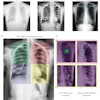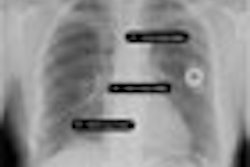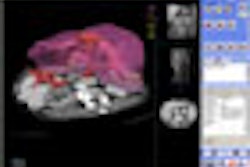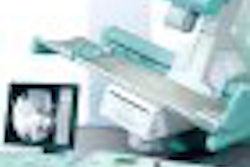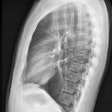CHICAGO - Although it's still in the investigational stage, breast tomosynthesis seems to offer the proverbial win-win situation, improving the sensitivity and specificity of cancer diagnosis, while also earning high marks from patients as a more comfortable exam, according to two studies presented Tuesday at the 2006 RSNA meeting.
Digital tomosynthesis relies on the parallax phenomenon, so that the x-ray moves through an arc, taking pictures from different angles, which are then synthesized into one image.
"The problem with (conventional) mammography is that everything on one side of the breast is superimposed on everything in the rest of the breast," said Dr. Daniel Kopans of Boston's Massachusetts General Hospital. He delivered the session's keynote address, outlining the basics of this developing technology.
"We can go through every plane in the breast with just a few pictures taken from different angles (with tomosynthesis)," Kopans said.
In the first paper presented, Joseph Lo, Ph.D., from Duke University Medical Center in Durham, NC, shared his group's clinical experience with breast tomosynthesis in 184 human subjects.
"What is most exciting about tomosynthesis is that it is fairly easily implemented with a straightforward modification to the hardware of a digital system," Lo said. It has the potential to be comparable to (full-field digital mammography [FFDM]) in terms of the (radiation) dose and scan times."
A prototype tomosynthesis system was installed on a commercially available FFDM unit (Mammomat Novation, Siemens Medical Solutions, Malvern, PA). The system uses an amorphous selenium, direct digital detector with a large area (23 x 29 cm), a pixel size of 85 micron, and a frame rate of two images per second. For this study, the system acquired 25 projection images over a 50° angular range in about 13 seconds. Preprocessing and reconstruction took between five and 10 seconds per image set.
The study population included 144 subjects, 58% of whom were undergoing routine screening (bilateral MLO views). Twenty-nine percent underwent diagnostic mammography, and 12% were slated for biopsy (bilateral MLO and CC views for diagnostic and biopsy cases). The images were reconstructed using filtered back projection. Two different graphical user interfaces, developed at Duke and at Siemens, were used to display the images.
The tomosynthesis images, as well as mammography, ultrasound, and MR images, were interpreted separately by co-author Dr. Jay Baker, who did not know the final outcome. Sensitivity for lesion detection and callback rates were recorded separately for each modality.
According to the results, 271 breasts were imaged with 264 views, for a total of 30 lesions and eight cancers. Of the 30 lesions, 27 were detected with tomosynthesis versus 21 of 30 found with mammography. The sensitivity of tomosynthesis was 90%, while the sensitivity for mammography was 70%.
Of the 30 lesions, both modalities found 19, including seven of eight cancers. Both modalities missed one benign mass. Mammography results promoted 42 callbacks for a rate of 15% compared with tomosynthesis, which had an 11% callback rate (28 cases).
Overall, the use of breast tomosynthesis improved detection sensitivity by 20% and reduced the callback rate by 33%.
Lo stressed that tomosynthesis is still an investigative technology and that his group's study was a single-reader project so observer variability was not analyzed. Future studies will have to be multisite with multiple readers, he said.
RSNA session moderator Dr. Carl D'Orsi of Emory University in Atlanta asked if Lo's group had seen any calcifications with tomosynthesis. Lo replied that the majority of their cases involved masses, which were seen better on tomosynthesis.
Tomosynthesis and patient comfort
In another study, Lo and Baker compared mammography to tomosynthesis with regard to compression and patient comfort in 100 women. The same patient population and imaging parameters as the previous study were used.
"The key point that I want to emphasize is that (tomosynthesis) does have a longer compression time than mammography," Lo said.
For both modalities, the technologists applied full compression, and the thickness of each breast was recorded. The women were then asked to rate their experience on a 10-point pain/discomfort scale for each modality (zero equaled no pain, 10 equaled worst pain ever) as well as a five-point final preference scale.
Despite the longer compression time required for tomosynthesis, patients still preferred the exam to mammography, Lo said. Seventy-five percent of the subjects said they preferred tomosynthesis by "a lot more" (52%) or "a little more" (23%).
While tomosynthesis required a longer compression time, it did result in a 12% decrease in compression and greater tissue compression thickness, by a mean of 1.8 mm, Lo said.
While the reduced compression did not adversely affect the sensitivity of tomosynthesis for lesion detection, it can bump up radiation dose, Lo noted. As a result, Lo's group had to calculate the potential loss of compression to adjust the dosage.
Lo acknowledged that there may have been several factors that influenced the outcomes of this study. First was technologist intent: Although the RTs were told to compress as needed, they may have held back because they knew the exam was for research purposes, Lo said. There also may have been a sequential bias as conventional mammography was always done before tomosynthesis.
By Shalmali Pal
AuntMinnie.com staff writer
November 28, 2006
Related Reading
US elasticity testing could cut breast biopsies by half, November 28, 2006
More DMIST analysis supports FFDM in younger women, dense breasts, November 26, 2006
MR mammo alters treatment course: A case study, October 19, 2006
Copyright © 2006 AuntMinnie.com


